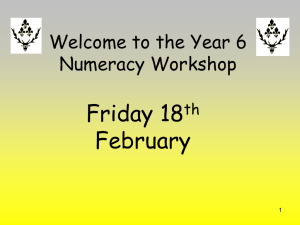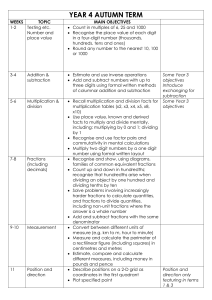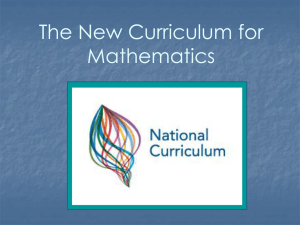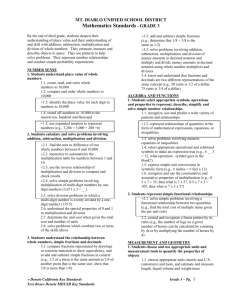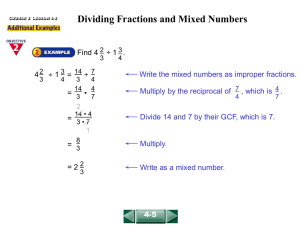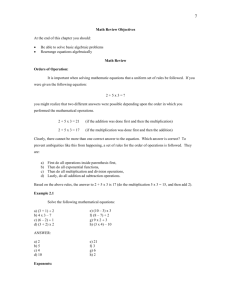Maths
advertisement
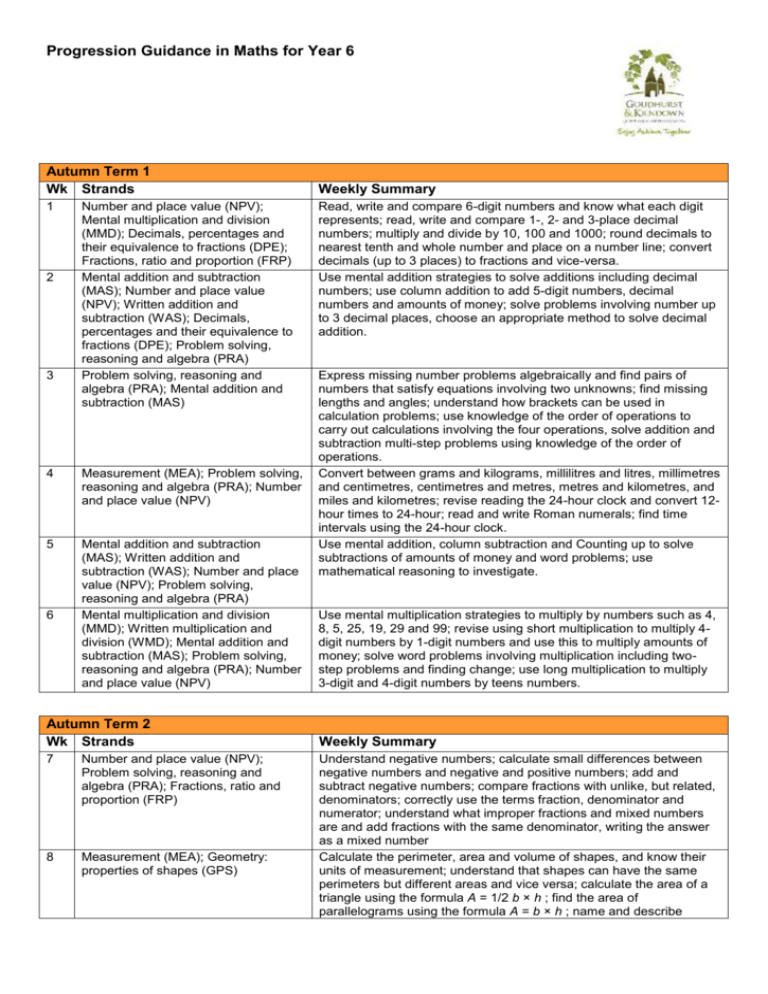
Progression Guidance in Maths for Year 6 Autumn Term 1 Wk Strands 1 2 3 Number and place value (NPV); Mental multiplication and division (MMD); Decimals, percentages and their equivalence to fractions (DPE); Fractions, ratio and proportion (FRP) Mental addition and subtraction (MAS); Number and place value (NPV); Written addition and subtraction (WAS); Decimals, percentages and their equivalence to fractions (DPE); Problem solving, reasoning and algebra (PRA) Problem solving, reasoning and algebra (PRA); Mental addition and subtraction (MAS) 4 Measurement (MEA); Problem solving, reasoning and algebra (PRA); Number and place value (NPV) 5 Mental addition and subtraction (MAS); Written addition and subtraction (WAS); Number and place value (NPV); Problem solving, reasoning and algebra (PRA) Mental multiplication and division (MMD); Written multiplication and division (WMD); Mental addition and subtraction (MAS); Problem solving, reasoning and algebra (PRA); Number and place value (NPV) 6 Autumn Term 2 Wk Strands 7 Number and place value (NPV); Problem solving, reasoning and algebra (PRA); Fractions, ratio and proportion (FRP) 8 Measurement (MEA); Geometry: properties of shapes (GPS) Weekly Summary Read, write and compare 6-digit numbers and know what each digit represents; read, write and compare 1-, 2- and 3-place decimal numbers; multiply and divide by 10, 100 and 1000; round decimals to nearest tenth and whole number and place on a number line; convert decimals (up to 3 places) to fractions and vice-versa. Use mental addition strategies to solve additions including decimal numbers; use column addition to add 5-digit numbers, decimal numbers and amounts of money; solve problems involving number up to 3 decimal places, choose an appropriate method to solve decimal addition. Express missing number problems algebraically and find pairs of numbers that satisfy equations involving two unknowns; find missing lengths and angles; understand how brackets can be used in calculation problems; use knowledge of the order of operations to carry out calculations involving the four operations, solve addition and subtraction multi-step problems using knowledge of the order of operations. Convert between grams and kilograms, millilitres and litres, millimetres and centimetres, centimetres and metres, metres and kilometres, and miles and kilometres; revise reading the 24-hour clock and convert 12hour times to 24-hour; read and write Roman numerals; find time intervals using the 24-hour clock. Use mental addition, column subtraction and Counting up to solve subtractions of amounts of money and word problems; use mathematical reasoning to investigate. Use mental multiplication strategies to multiply by numbers such as 4, 8, 5, 25, 19, 29 and 99; revise using short multiplication to multiply 4digit numbers by 1-digit numbers and use this to multiply amounts of money; solve word problems involving multiplication including twostep problems and finding change; use long multiplication to multiply 3-digit and 4-digit numbers by teens numbers. Weekly Summary Understand negative numbers; calculate small differences between negative numbers and negative and positive numbers; add and subtract negative numbers; compare fractions with unlike, but related, denominators; correctly use the terms fraction, denominator and numerator; understand what improper fractions and mixed numbers are and add fractions with the same denominator, writing the answer as a mixed number Calculate the perimeter, area and volume of shapes, and know their units of measurement; understand that shapes can have the same perimeters but different areas and vice versa; calculate the area of a triangle using the formula A = 1/2 b × h ; find the area of parallelograms using the formula A = b × h ; name and describe 9 10 11 Mental multiplication and division (MMD); Fractions, ratio and proportion (FRP); Written multiplication and division (WMD); Problem solving, reasoning and algebra (PRA) Fractions, ratio and proportion (FRP); Problem solving, reasoning and algebra (PRA); Decimals, percentages and their equivalence to fractions (DPE) Fractions, ratio and proportion (FRP) Spring Term 1 Wk Strands 12 Number and place value (NPV); Written addition and subtraction (WAS) 13 Decimals, percentages and their equivalence to fractions (DPE); Fractions, ratio and proportion (FRP) 14 Mental multiplication and division (MMD); Written multiplication and division (WMD); Problem solving, reasoning and algebra (PRA); Number and place value (NPV) Geometry: properties of shapes (GPS); Problem solving, reasoning and algebra (PRA) 15 16 Mental addition and subtraction (MAS); Number and place value (NPV); Written addition and subtraction (WAS); Problem solving, reasoning and algebra (PRA) 17 Written multiplication and division (WMD); Number and place value (NPV); Problem solving, reasoning and algebra (PRA) Spring Term 2 Wk Strands 18 Mental addition and subtraction (MAS); Written addition and subtraction (WAS); Problem solving, reasoning and algebra (PRA) properties of 3D shapes; systematically find and compare nets for different 3D shapes. Use mental strategies to divide by 2, 4, 8, 5, 20 and 25; find non-unit fractions of amounts; use short division to divide 3- and 4-digit numbers by 1-digit numbers, including those which leave a remainder; express a remainder as a fraction, simplifying where possible. Add and subtract unit fractions with different denominators including mixed numbers; use mental strategies to find simple percentages of amounts, including money Multiply fractions less than 1 by whole numbers, converting improper fractions to whole numbers; use commutativity to efficiently multiply fractions by whole numbers; divide unit and non-unit fractions by whole numbers; solve word problems involving fractions. Weekly Summary Read and write numbers with up to 7-digits, understanding what each digit represents; work systematically to find out how many numbers round to 5000000; solve subtraction of 5- and 6-digit numbers using written column method (decomposition). Multiply and divide by 10, 100 and 1000; compare and order numbers with up to three decimal places; know common fraction / decimal equivalents; multiply pairs of unit fractions and multiply unit fractions by non-unit fractions Use partitioning to mentally multiply 2-digit numbers with one decimal place by whole 1-digit numbers; multiply numbers with two decimal places; use short multiplication to multiply amounts of money; use estimation to check answers to calculations; use long multiplication to multiply 3-digit and 4-digit numbers by numbers between 10 and 30. Name, classify and identify properties of quadrilaterals; explore how diagonal lines can bisect quadrilaterals; understand what an angle is and that it is measured in degrees; know what the angles of triangles, quadrilaterals, pentagons, hexagons and octagons add to and use these facts and mathematical reasoning to calculate missing angles; recognise and identify the properties of circles and name their parts; draw circles using pairs of compasses; draw polygons using a ruler and a protractor Add and subtract numbers using mental strategies; solve addition of 4to 7-digit numbers using written column addition; identify patterns in the number of steps required to generate palindromic numbers; solve subtraction of 5-, 6- and 7-digit numbers using written column method (decomposition); solve additions and subtractions choosing mental strategies or written procedures as appropriate; read, understand and solve word problems Identity common factors and common multiples; understand that a prime number has exactly two factors and find prime numbers less than 100; understand what a composite (non-prime) number is; use long division to divide 3- and 4-digit numbers by 2-digit numbers, giving remainders as a fraction, simplifying where possible Weekly Summary Solve addition and subtraction multi-step problems in shopping contexts, and add and subtract money using column addition and counting up; add and subtract decimal numbers choosing an appropriate strategy, and add decimal numbers with different numbers of places using column addition; use mathematical reasoning to 19 Statistics (STA); Decimals, percentages and their equivalence to fractions (DPE) 20 Geometry: position and direction (GPD); Number and place value (NPV); Problem solving, reasoning and algebra (PRA); Geometry: properties of shapes (GPS) 21 Written multiplication and division (WMD); Problem solving, reasoning and algebra (PRA) 22 Problem solving, reasoning and algebra (PRA); Fractions, ratio and proportion (FRP) investigate and solve problems, and solve subtractions of decimal numbers with different numbers of places (2-places) using counting up Calculate and understand the mean average; construct and interpret distance/time line graphs where intermediate points have meaning, including conversion line graphs; understand pie charts are a way of representing data using percentages, interpret and construct pie charts Read and plot coordinates in all four quadrants, draw and translate simple polygons using coordinates and find missing coordinates for a vertex on a polygon; draw and reflect simple polygons in both the x-axis and y-axis using coordinates; find unknown angles around a point, on a line, in a triangle or vertically opposite and in polygons where diagonals intersect Multiply 4-digit numbers including those with two decimal places by 1digit numbers; use long multiplication to multiply 4-digit numbers by numbers between 10 and 30, including those with two decimal places; revise using short division to divide 4-digit by 1-digit and 2-digit numbers including those which leave a remainder, and divide the remainder by the divisor to give a fraction, simplifying where possible, and make approximations; use long division to divide 4-digit by 2-digit numbers, and use a systematic approach to solve problems Generalise a relationship between pairs of numbers, express simple formulae in words, then using letters; describe and continue sequences, generalise to predict the tenth term, begin to generalise a term in a sequence using n to stand for the number of the term in a sequence; describe ratio and use ratio to solve problems; find fractions and simplify ratios


